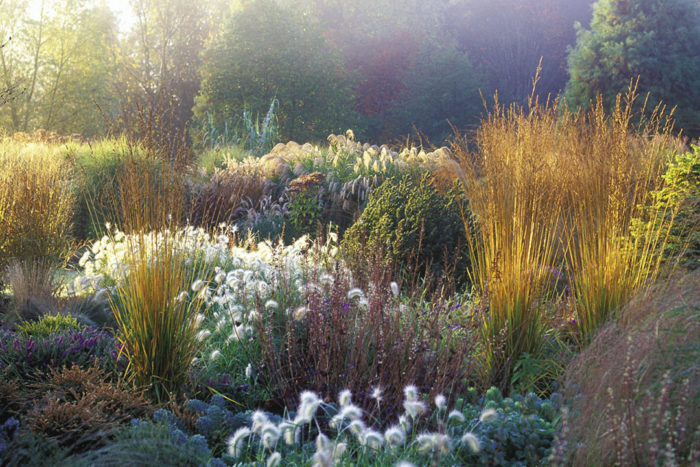
A couple of old-school gardeners I admire believe that ornamental grasses belong in meadows or along the shore, not in the garden. I reluctantly agree that grasses can dress the garden with a pizzazz bordering on wild abandonment, but I have to insist that most of us really need something besides the flattened blades of daylilies and irises to contrast with our gardens’ mélange of round-leaf textures and woody plant shapes. And grasses are better than anything else at capturing summer’s light and refracting it like a gemstone. In fact, grasses are to the garden what a scarf and earrings are to my inner French woman: necessary accessories. Long blades, like a silver necklace, give the light a shiny surface for our eyes to wander along. Airy blooms wrap around the garden like a stole, embellishing its natural beauty. And sparkling seed heads are its diamond bling.
Most of us have in our gardens the everyday grasses, like miscanthus (Miscanthus spp. and cvs., USDA Hardiness Zones 4–9) and fountain grass (Pennisetum spp. and cvs., Zone 6–11). They’re comfortable and sturdy, but most of us would have to admit that they’re wearing thin on excitement. The finest, most coveted jewels are almost always the uncommon ones. There are many grasses worth seeking out when you want to give your garden a dash of panache.
These annual selections are easy to grow and utterly adorable
Dusky blades and arching seeds
Name: Ornamental rice (Oryza sativa cvs.)
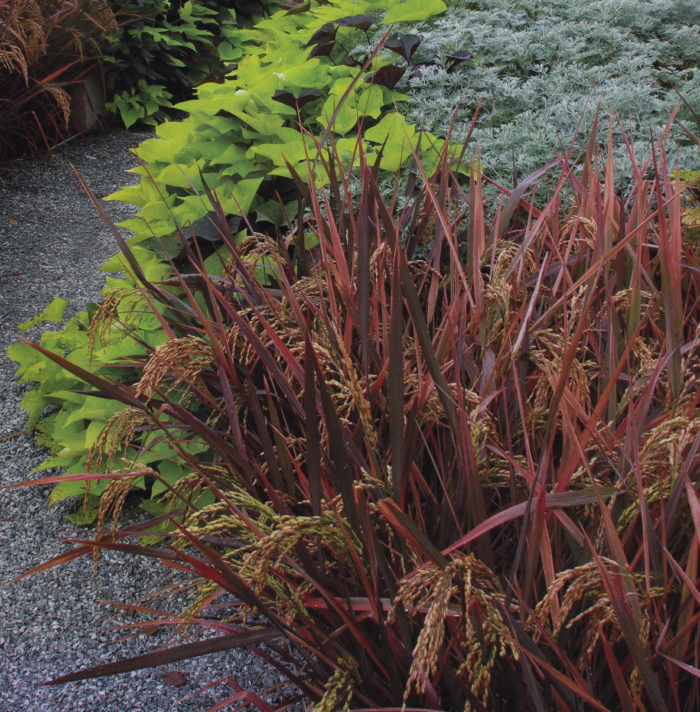
Considering how common rice is in our diet, it’s surprisingly unusual to find it in our gardens. But most of us who grow ornamental rice are more interested in its subtle, exotic beauty than its nutritional value. I grow cultivars like ‘Black Madras’ and ‘Red Dragon’ for their 18-inch-tall, dusky, rainbow-colored blades, which dress my garden with glamorous sophistication. Gorgeous green seeds form toward the end of the season, revealing themselves only as they gain weight and arch outward from the foliage like beaded spangles. Ornamental rice will thrive in consistently moist to wet soil, so plant it near a pond or in a sunny rain garden or keep it saturated in a container fitted with a saucer.
USDA Hardiness Zones: Annual
Bloom time: Late summer
Size: 18 to 24 inches tall and 1 foot wide
Conditions: Full sun; moist to wet, fertile soil
Soft, touchable blooms
Name: Bunny tail grass (Lagurus ovatus)

Bunny tail grass is so cute that you’ll want to plant it in your pocket. Angora-soft tassels beg to be picked and stroked and kept forever. But even though picking them prolongs the bloom—as would faithfully deadheading any annual—this is a cool-season grass that comes into bloom early and goes to seed quickly once summer’s heat sets in. It doesn’t matter, though, because the cottontails don’t self-destruct and will look even more adorable dried on the plant than they do in a vase. Plant this grass as fringe along the garden’s sunniest edges, tucked wherever its curls of tanned midsummer leaves won’t tempt you to pull their threads out. In midsummer, plant some more seeds in pots, three to six per pot, or sow them directly for a shot at late-summer spring-green posies as temperatures cool back down.
Zones: Annual
Bloom time: Early summer
Size: 20 inches tall and 1 foot wide
Conditions: Full sun; fertile, well-drained soil
Fireworks that last all summer
Name: ‘Frosted Explosion’ switchgrass (Panicum elegans ‘Frosted Explosion’)
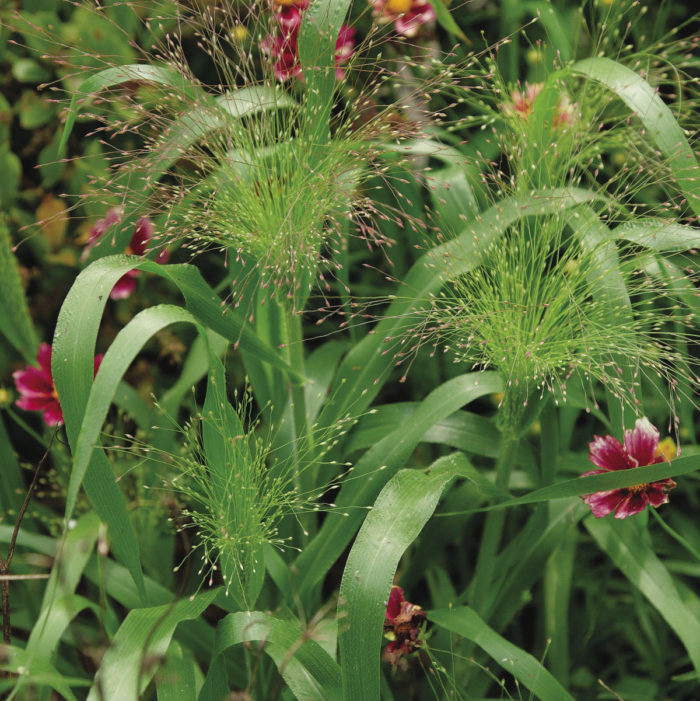
Picture waving a sparkler around on the Fourth of July. Now picture it staying lit for the whole summer. The blooms of ‘Frosted Explosion’ switchgrass burst out of their stems in midsummer (provided you start seeds in midspring), and the wands are so lovely in arrangements that it was awarded the 2010 Cut Flower of the Year (dried-flower category) by the Association of Specialty Cut Flower Growers. Cutting keeps it blooming, but its celebratory beauty is by no means diminished as the flowers fade to frothy seed heads, which hang on into fall. ‘Frosted Explosion’ looks best in tight clumps spaced no more than 12 inches apart. But weeders, beware: Its seedlings look an awful lot like crabgrass.
Zones: Annual
Bloom time: Midsummer
Size: 24 to 32 inches tall and 1 to 2 feet wide
Conditions: Full sun; fertile, well-drained soil
Papery jewels that shiver in the breeze
Name: Big quaking grass (Briza maxima)
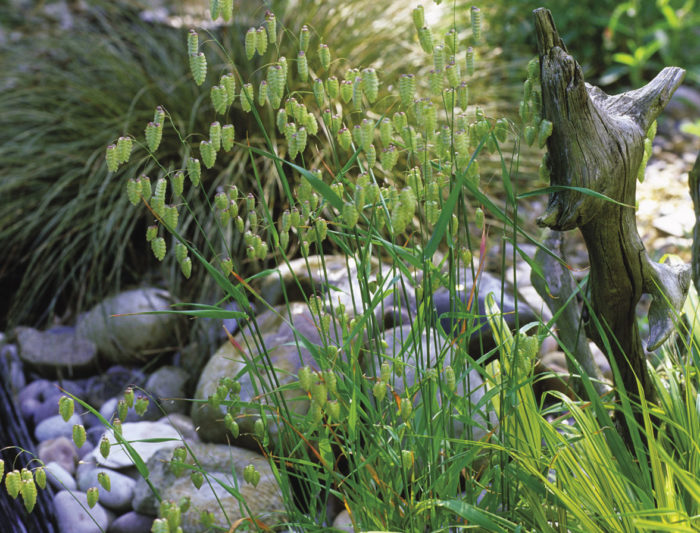
Beginning in early summer, big quaking grass dons spikelets of puffed seed heads that shimmy in the wind and dangle like green-gold earrings from impossibly fine stems. The seed heads are often described as fairy lanterns, but to me, they have a certain insect quality; perhaps it has to do with their animated heart-shaped “body” or the way they catch the light. Place these slender beauties in tight drifts, 6 to 10 inches apart, where they’ll be backlit against the morning or setting sun, and give them a front-row seat with anything they can hover over without interference. Aggressive self-sowing may be managed somewhat by picking spikelets before they’ve gone to seed and using them in flower arrangements.
Zones: Annual
Bloom time: Late spring to late summer
Size: Up to 2 feet tall and 10 inches wide
Conditions: Full sun; well-drained soil
In warmer climates, these grasses will come back year after year
Windswept tresses
Name: Foxtail barley (Hordeum jubatum)
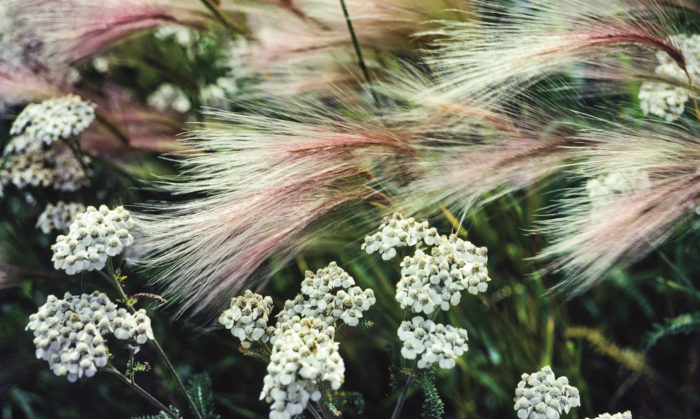
Nodding sprays of salmon-pink flowers have earned foxtail barley, a native roadside weed, a place in our gardens to wind like a boa through fellow June- and July-flowering plants, like ox-eye daisy (Leucanthemum vulgare, Zones 3–8) and black-eyed Susan (Rudbeckia spp. and cvs., Zones 3–11). As a cool-season grass, foxtail barley is at its best as late-blooming grasses are still shooting out their leaves. Its luminous plumage fades to beige on barbed seed heads, which shatter and disperse (by attaching to the clothes of passersby) just as the late bloomers are ready to take over the show. Foxtail barley will self-sow in most gardens and in any soil. So the trick after getting it established is simply to edit out any unwanted seedlings—and keep the plant as far as possible from livestock pastures because its seed heads can severely damage a cow’s or horse’s mouth.
Zones: 4 to 8
Bloom time: Early to midsummer
Size: Up to 20 inches tall and 1 foot wide
Conditions: Full sun; fertile, well-drained soil
Coppery mounds of loveliness
Name: Orange New Zealand sedge (Carex testacea and cvs.)

Orange New Zealand sedge is known for its mounds of superfine, deep olive green threads that tint outward to sunset orange. Although this sedge can take some shade, it will glow more luminously if you give it a sunny spot where the soil remains that ideal and elusive combination of moist and well drained. If your garden is like mine and has no suitable spot, plant a few of them, instead, in containers. Sedges are unusual among grasses for generally being evergreen and not needing to be cut down in late winter. But to make way for new growth, comb out the dead bits and keep an eye out for any politely proffered seedlings. Wherever it isn’t reliably hardy, bring it inside to a bright drafty window for the winter. Buy this one as a full-grown plant because starting it from seed can be a challenge.
Zones: 7 to 9
Bloom time: Midsummer
Size: 18 to 24 inches tall and wide
Conditions: Full sun to partial shade; moist, well-drained soil
A vision in pink
Name: Ruby grass (Melinis nerviglumis and cvs.)

I would grow ruby grass simply for its blue-green foliage, but when it tops that with silken, feathery pink blooms, I’m a smitten kitten. Ruby grass stands out from the crowd, so don’t put this Baby in a corner. Let it take center stage under a spotlight sun, and watch it dance with a Swayze breeze. If it must blend with a crowd, place it along a front edge or tucked neatly into a ground cover. As the flowers turn to seed heads, they become a tea-stained color before blowing away. Deadheading to keep it in bloom isn’t necessary. But the flowers do last in arrangements, so you might as well use them.
Zones: 8 to 10
Bloom time: Midsummer
Size: 18 to 24 inches tall and 12 to 18 inches wide
Conditions: Full sun; fertile, well-drained soil
Bright, feathery tassels
Name: Feathertop grass (Pennisetum villosum)

Fountain grasses are known for their fluffy blooms, but none is as cream-puffy as feathertop grass. Fountain grasses are also well known for their gracefully flowing foliage; here, again, feathertop grass takes the cake. Endless narrow blades form a generous hoop skirt of foliage to support flounces of flowers beginning in August and continuing to a hard frost. Sow no more than two or three seeds per pot, and plan to give this one its full 2-foot-wide allotment of space to keep it from sitting on its neighbors.
Zones: 8 to 10
Bloom time: Mid-to-late summer
Size: Up to 2 feet tall and wide
Conditions: Full sun; fertile, well-drained soil
A glamorous redhead
Name: Red hook sedge (Uncinia uncinata ‘Rubra’)
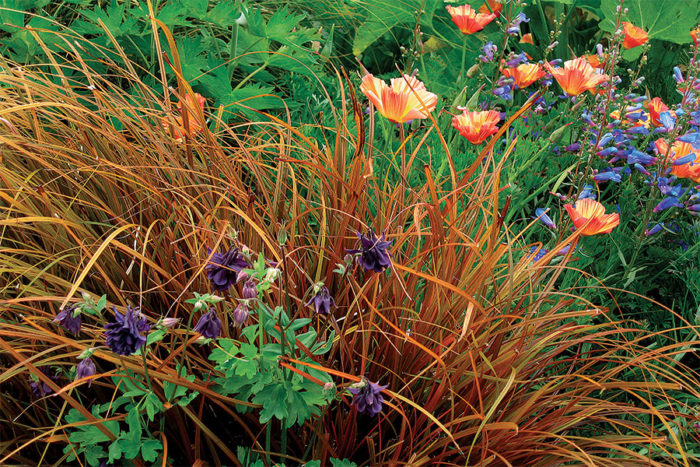
New Zealand native red hook sedge shines with its own odd light. Roughly curled and folded red blades erupt into a dense clump and send up dark flower spikes in late summer. One red hook sedge would be pretty enough as a garnet pendant in a container, but as a beaded necklace strung around the garden, it would be even lovelier. Let it provide a contrast with extraleafy plants, like bergenia (Bergenia spp. and cvs., Zones 3–9) or lettuces; how monochromatically chic it would be with the red-leaf lettuce varieties, like ‘Lolla Rossa’. Where it isn’t hardy, bring in red hook sedge and place it in a cool window for the winter. Comb out dead blades in early spring to make room for fresh growth.
Zones: 8 to 11
Bloom time: Late summer
Size: 12 to 14 inches tall and wide
Conditions: Partial to full shade; moist to boggy soil
Shifting shades of steel
Name: Blue wheatgrass (Elymus magellanicus)
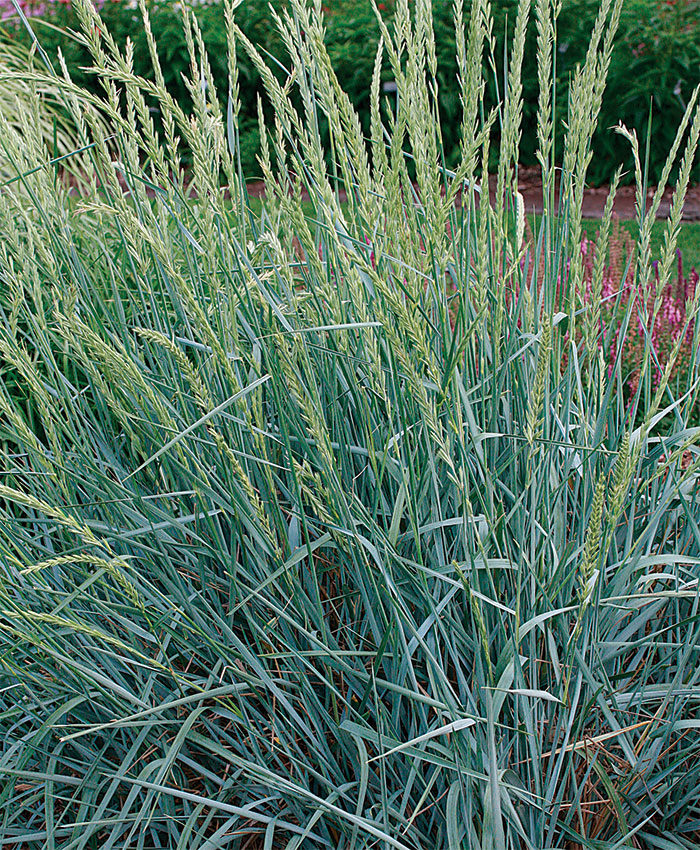
When garden conditions are perfect, the slender blades of blue wheatgrass fall outward from a central clump, and they shift in the light from sterling silver to aquamarine. When conditions are imperfect—as when the soil is bone dry or the summers are hot and humid—the leaves are likely to tarnish with a rust fungus or scorch to crisps. The only thing to do is give this grass everything it wants: partial midsummer shade, the best soil, and regular irrigation for resplendent and shimmering blueness. In warm zones, it will be everblue but should always be cut back in early spring to make way for new growth and modest May flowers.
Zones: 6 to 10
Bloom time: Midspring
Size: 1 to 2 feet tall and wide
Conditions: Full sun; moist, well-drained soil
I can’t imagine inviting any of these ornamental grasses into an elegant and formally attired English-style border garden. But any garden with an au courant naturalistic mix of plants absolutely needs them. This winter, take a look through the seed catalogs and nursery websites; no doubt you’ll find dozens of beauties I neglected to mention.
Starting Grasses From Seed Is Easy
Growing grasses from seed couldn’t be easier, less expensive, or more rewarding. It also ensures that you’ll have plenty to show off in generous clumps and drifts. While most vegetable seedlings need to be thinned, seed-grown grasses are slender, delicate things that benefit from a bit of crowding. Several seeds can be packed in a pot to give the plants the bulk they need to keep from looking spindly in the garden.
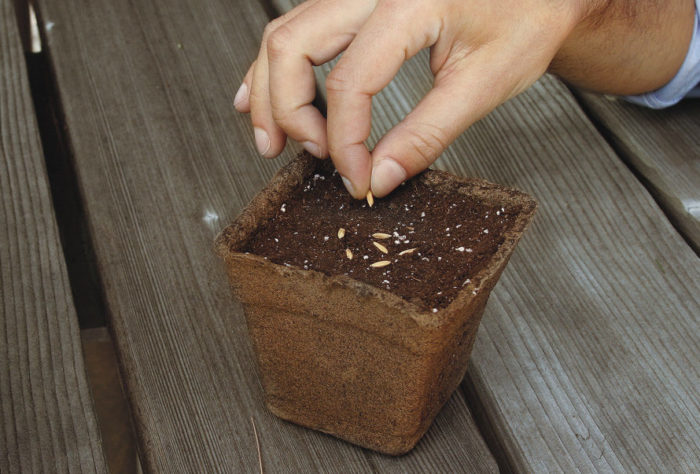
1. Start in late winter or early spring, sowing three to six seeds per pot in fine-textured potting soil. Cover them lightly with the same soil. Check the package for any specific sowing instructions; if there are none, assume that the seeds will need only light, heat, and moisture to germinate.
Place the pots indoors on a sunny windowsill or under grow lights. If you don’t have a heating mat, move trays from their window sunbeams or grow lights to the top of the refrigerator at night, or water the pots with tepid water.
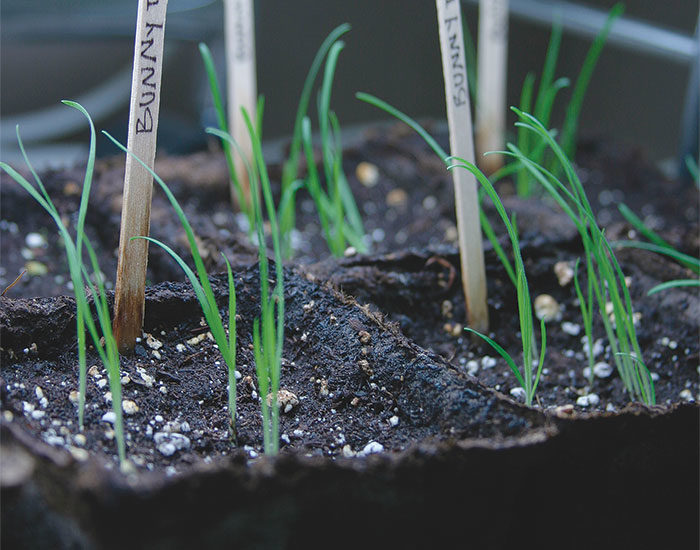
2. Keep the soil moist as seedlings develop. The more tightly packed they are in their pots, the more crucial it is to keep an eye on moisture levels as their roots fill in.
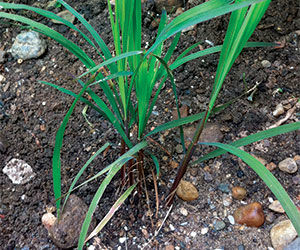
3. Move the seedlings outside during the day to harden off as night temperatures reach 55°F, then plant them out after the last frost, giving them only the space they’ll need to arch their blades when they’ve reached their full size. Most look fabulous planted in tight drifts and clumps. Fat grasses, like orange New Zealand sedge, feathertop grass, and ruby grass, need extra space to display their graceful girth.
Kristin Green is an interpretive horticulturist at Blithewold Mansion, Gardens and Arboretum in Bristol, Rhode Island.
Photos, except where noted: Michelle Gervais
Sources
- Digging Dog Nursery, Albion, Calif.; 707-937-1130; diggingdog.com
- Park Seed Co., Greenwood, S.C.; 800-845-3369; parkseed.com
- Seedman.com, 3421 Bream St., Gautier, MS 39553; seedman.com
- Thompson & Morgan, Aurora, Ind.; 800-274-7333; tmseeds.com



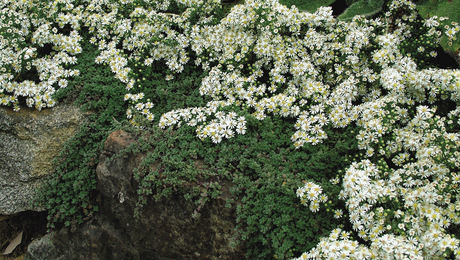














Comments
Log in or create an account to post a comment.
Sign up Log in